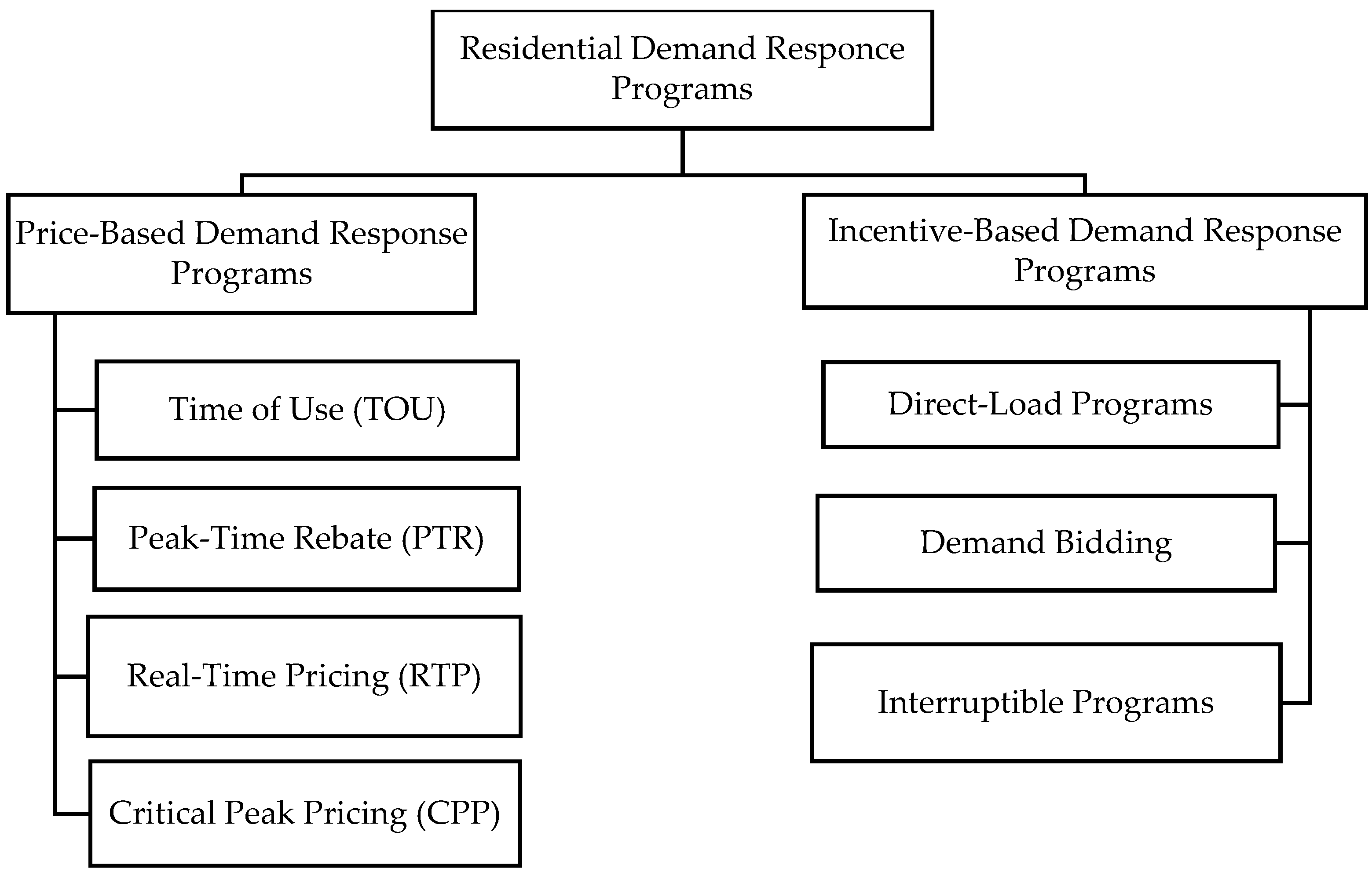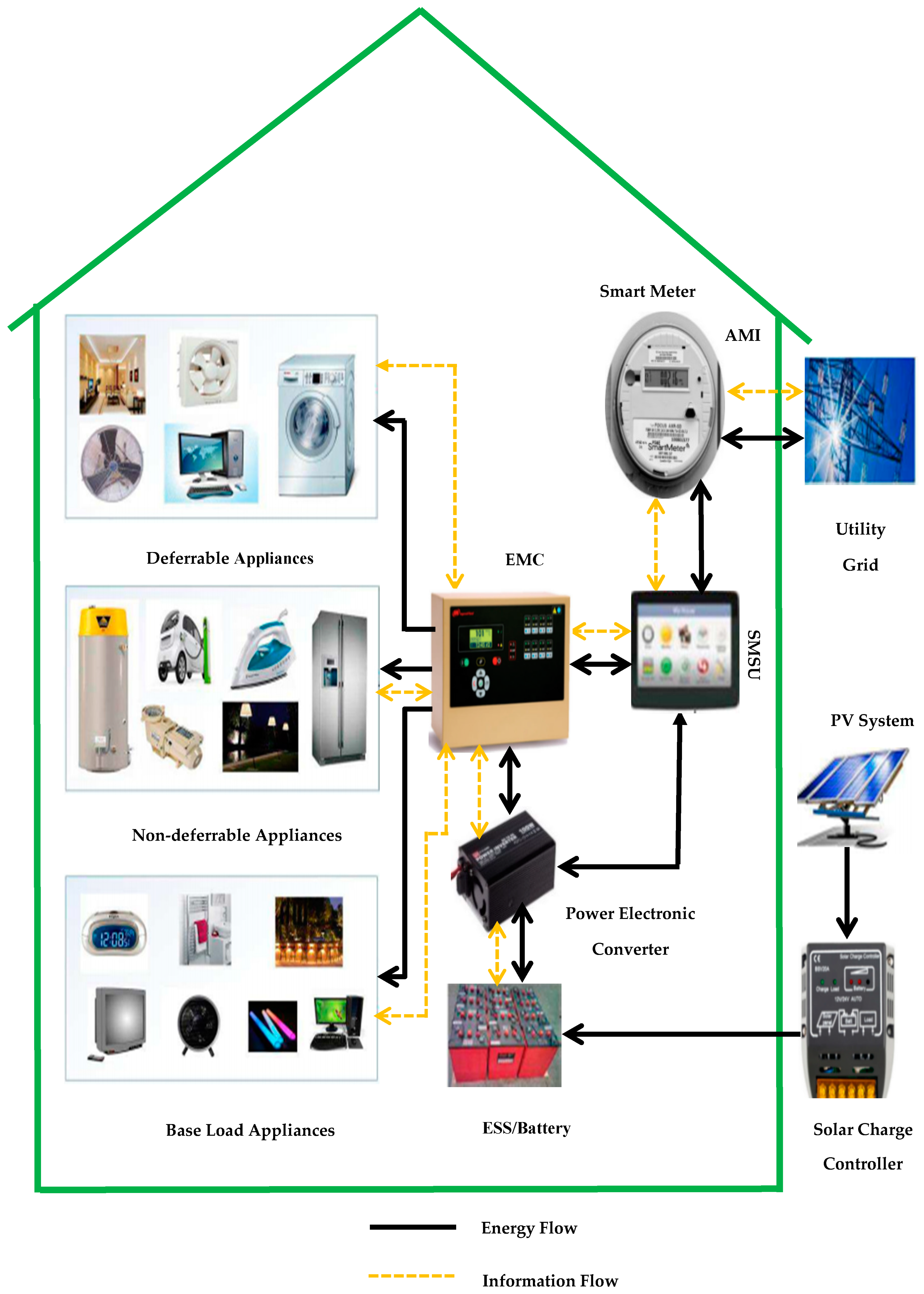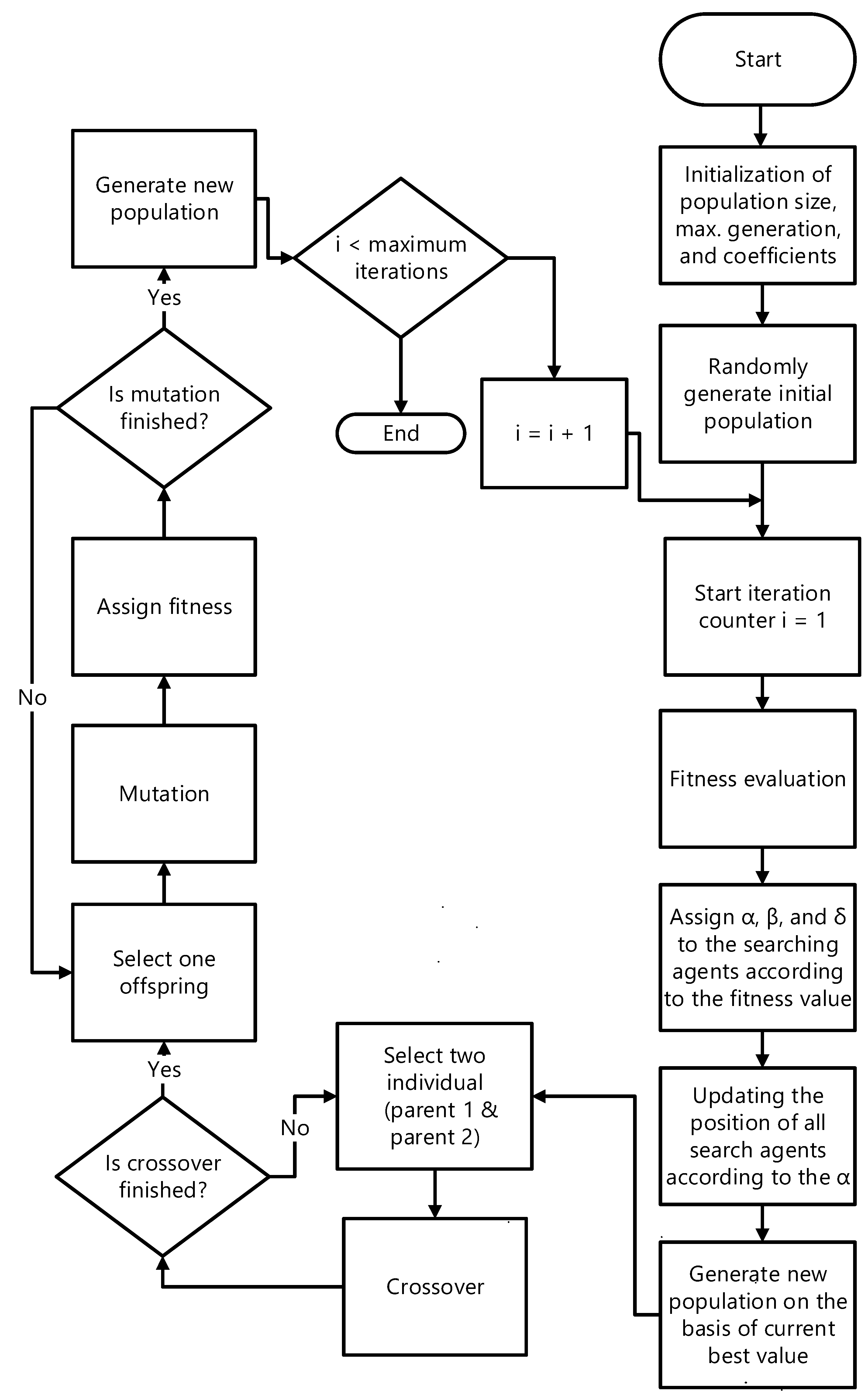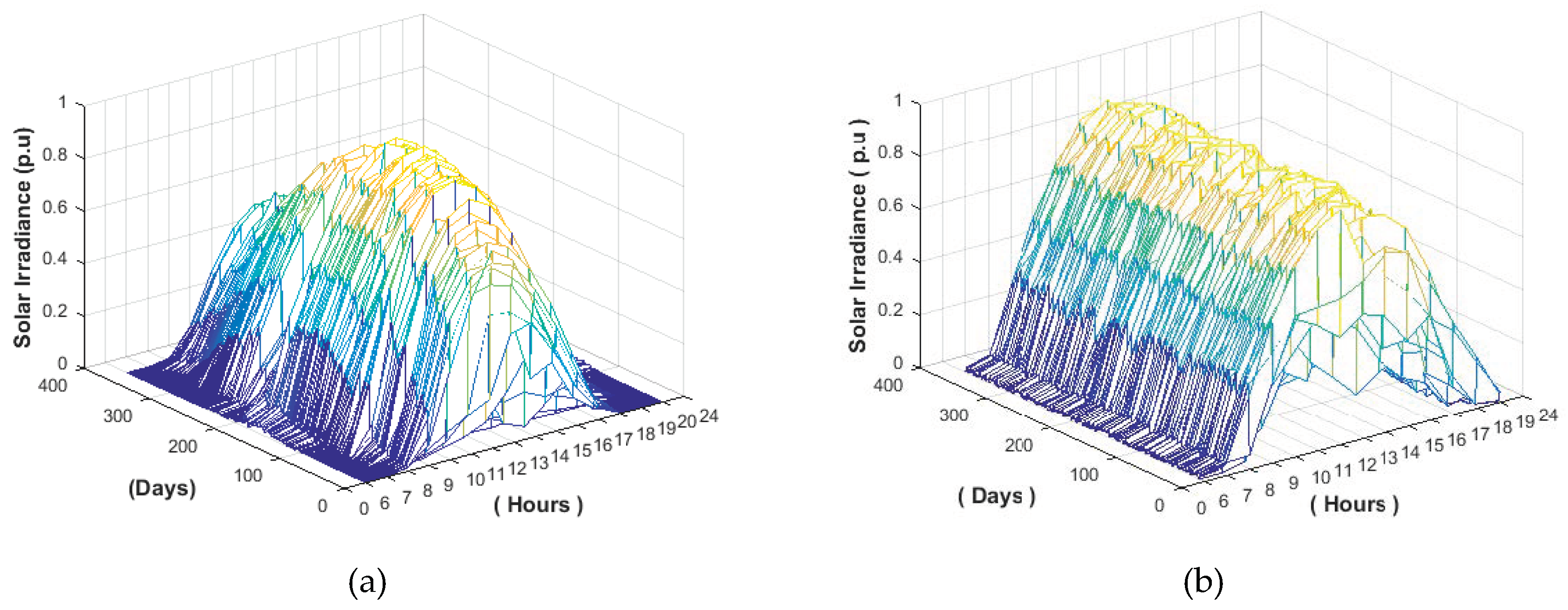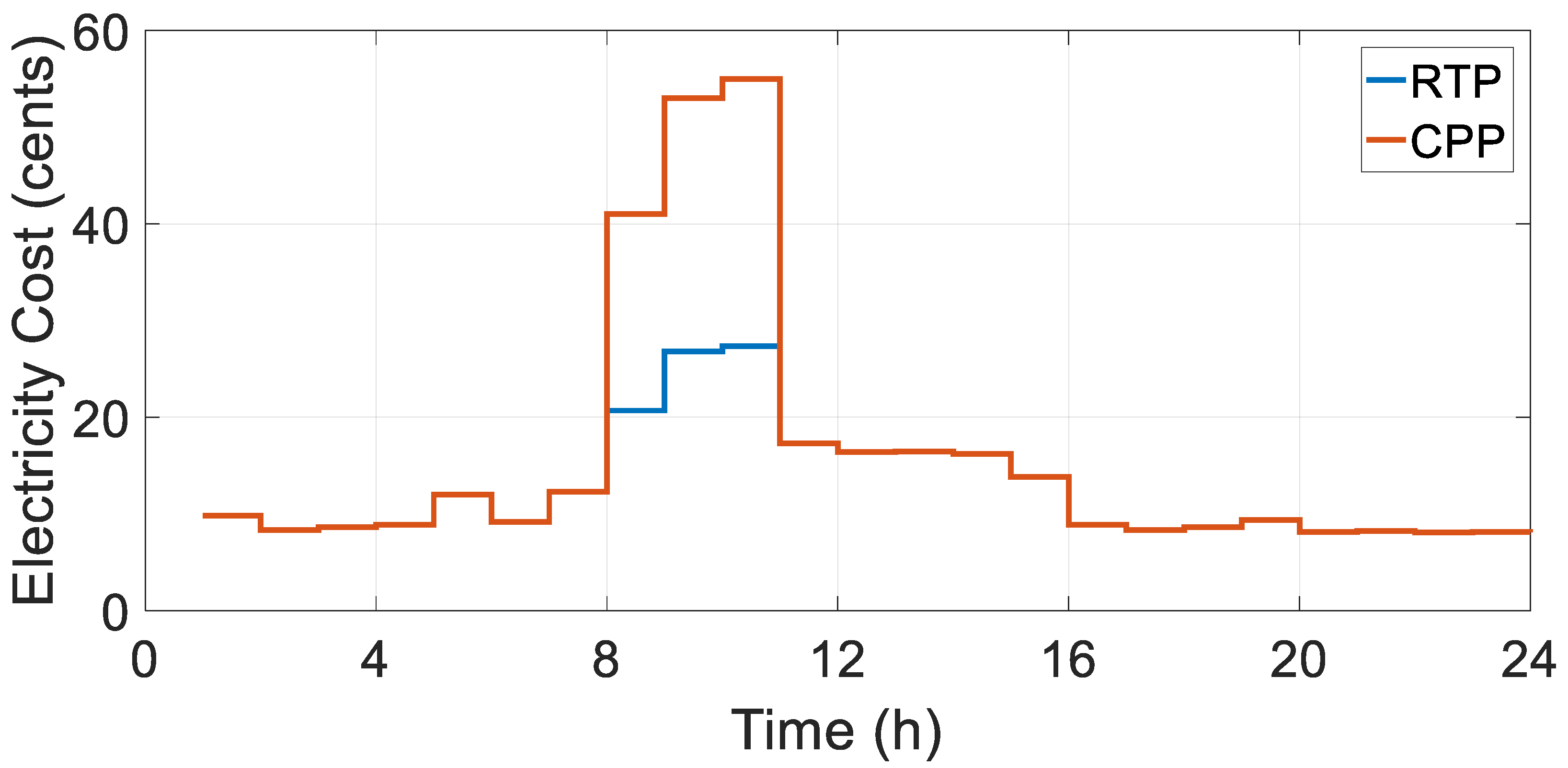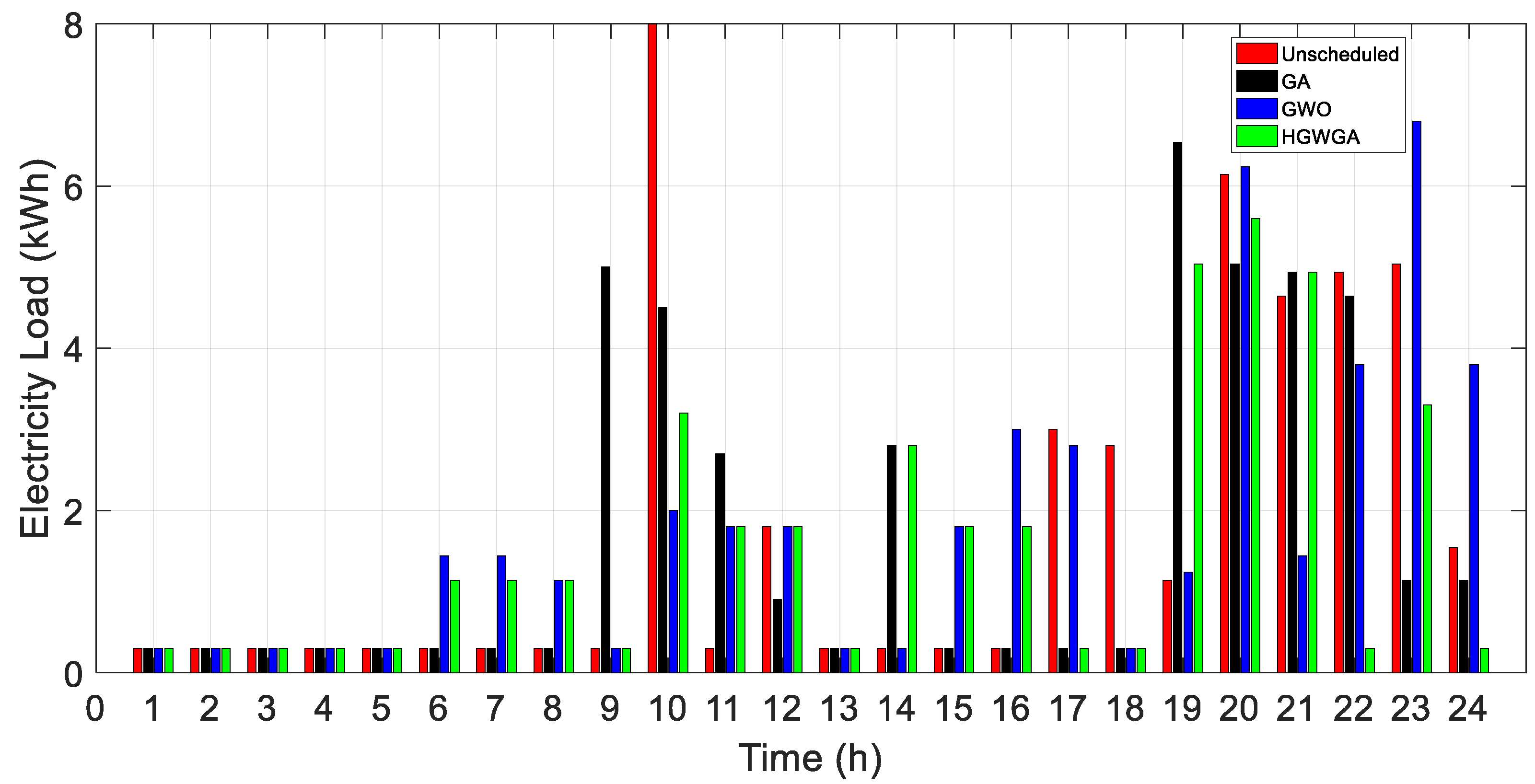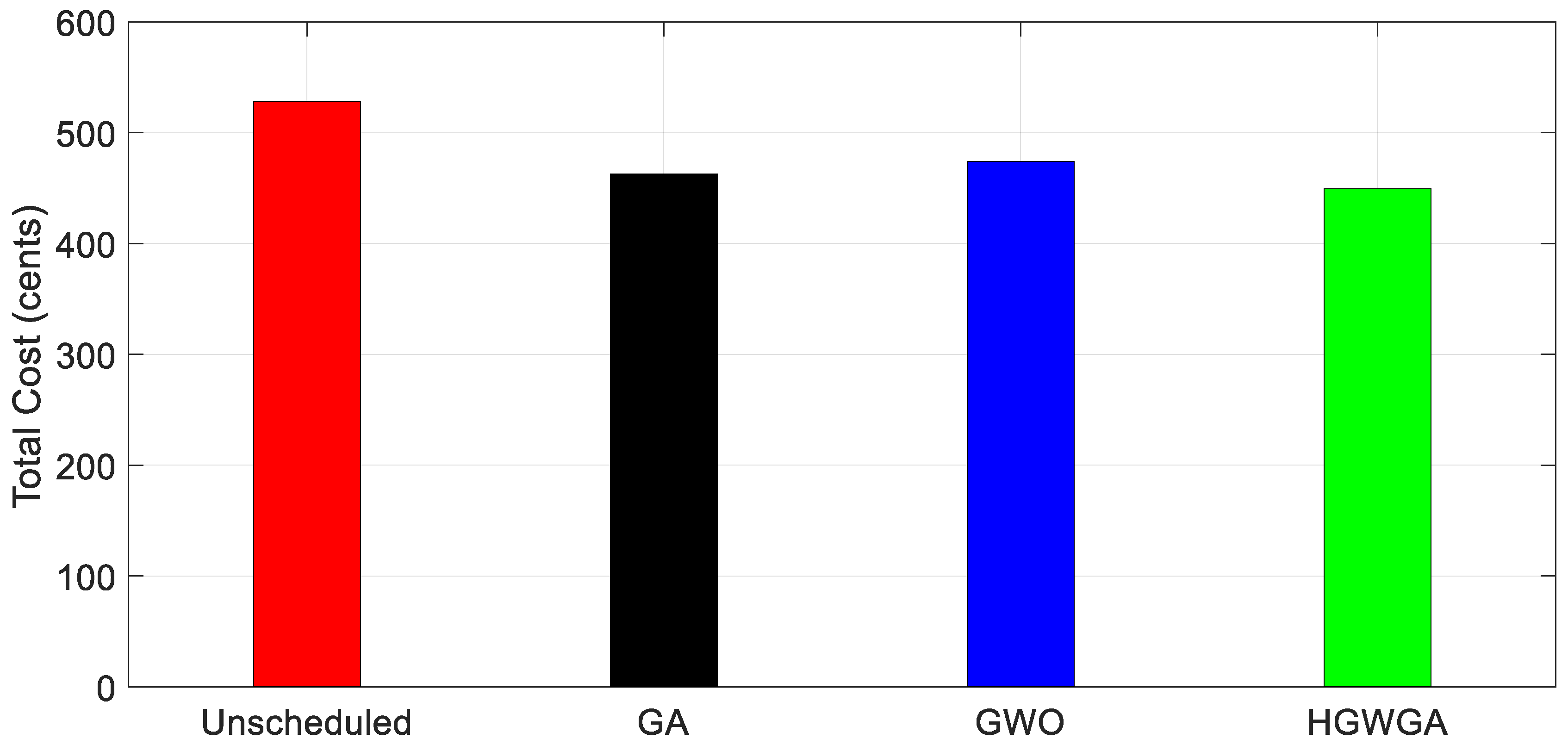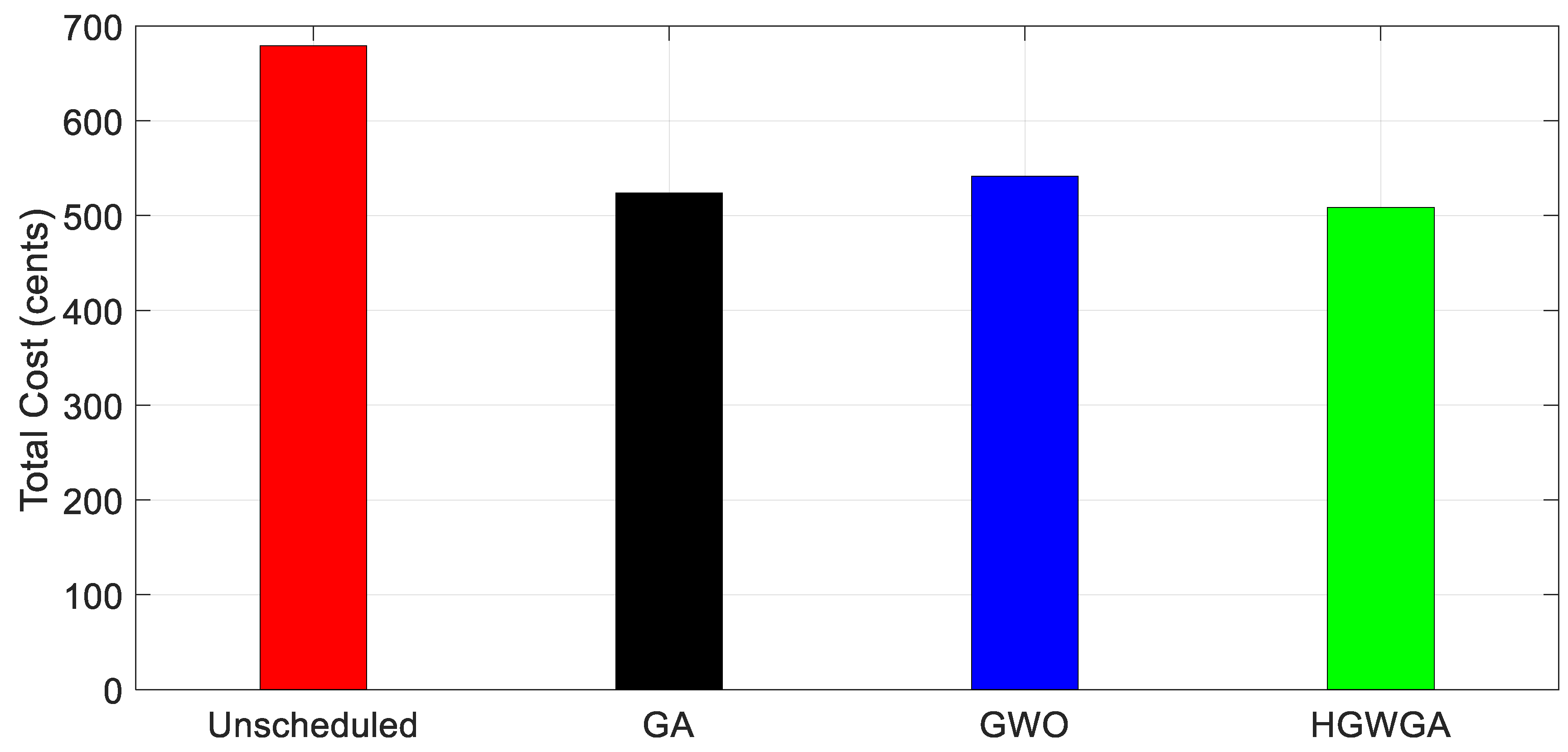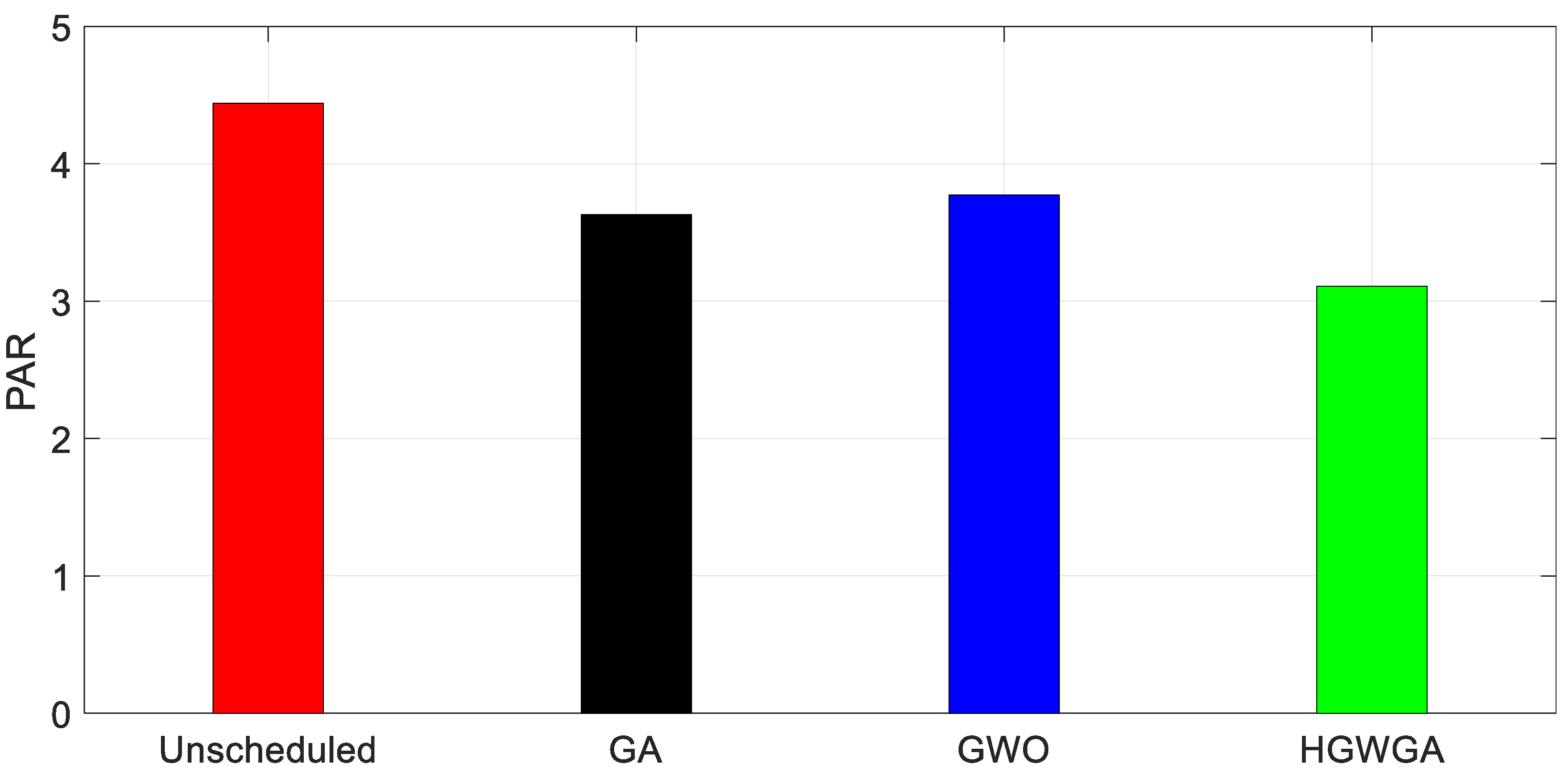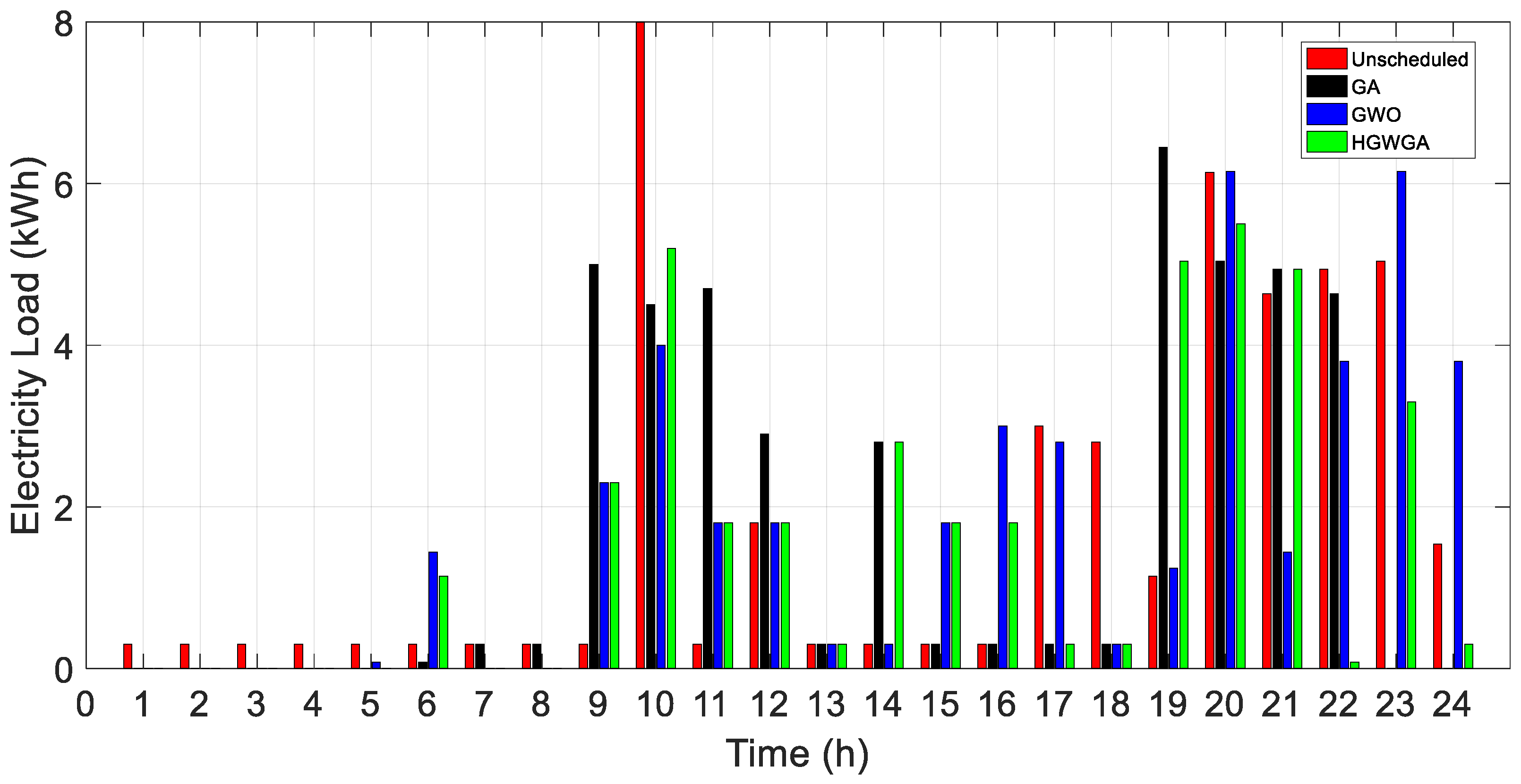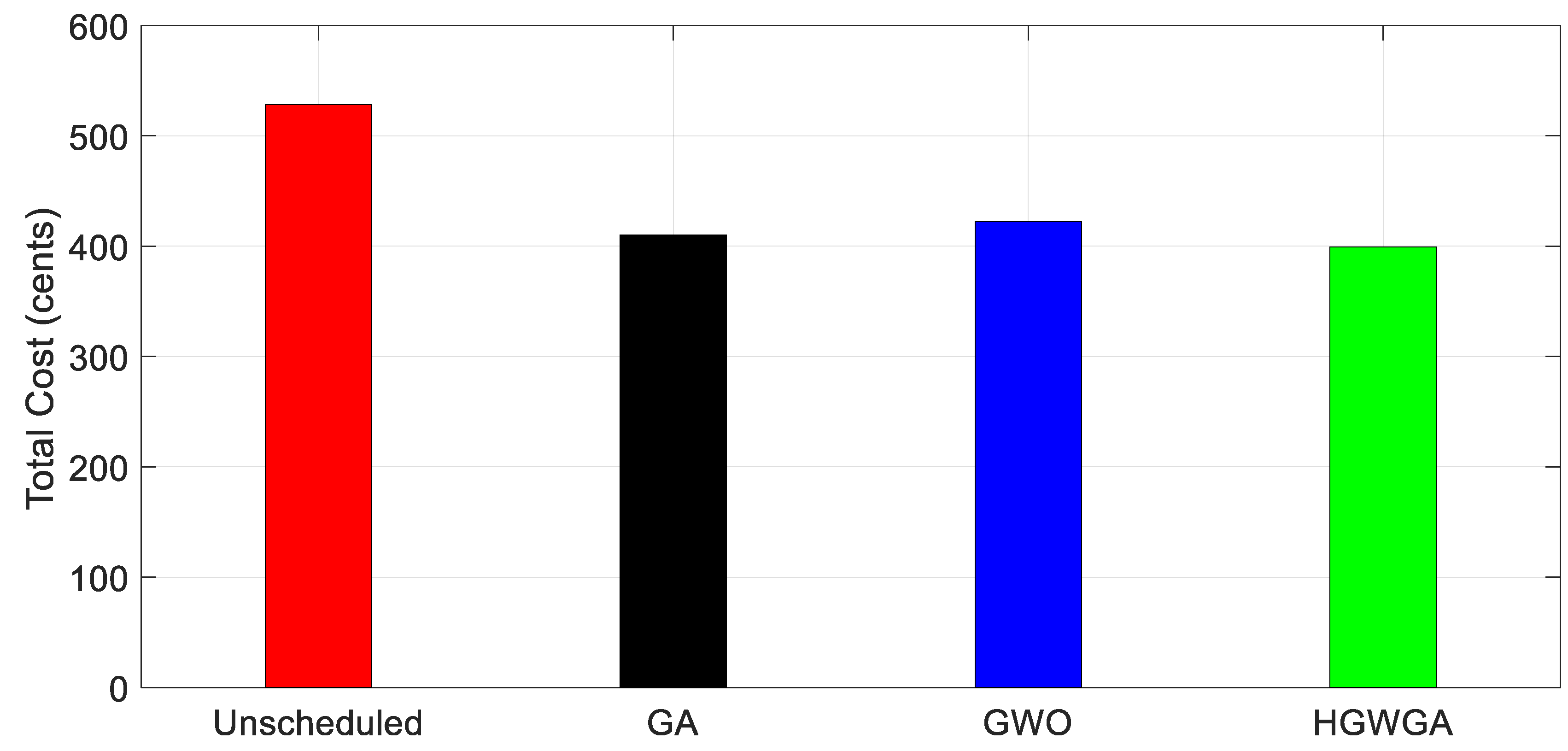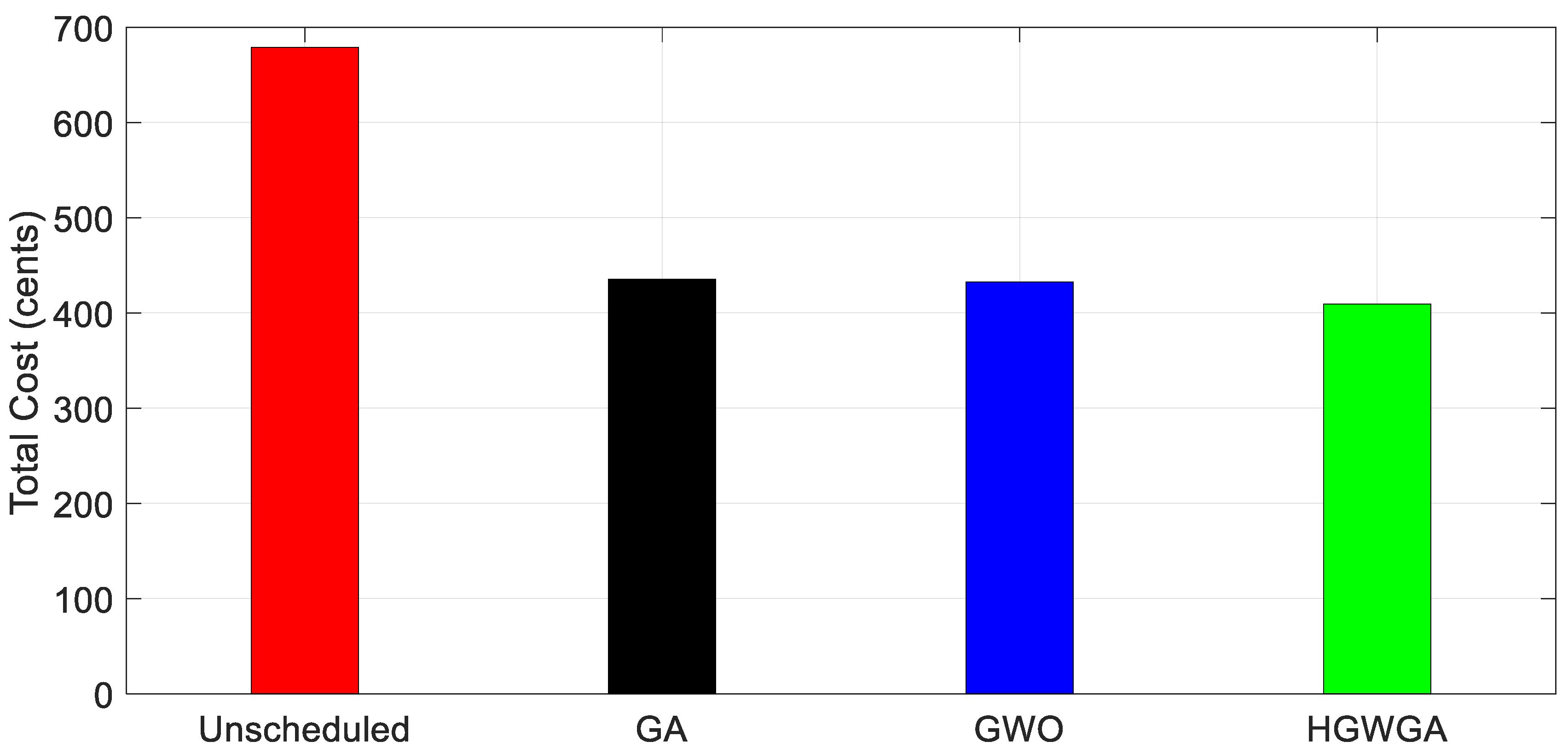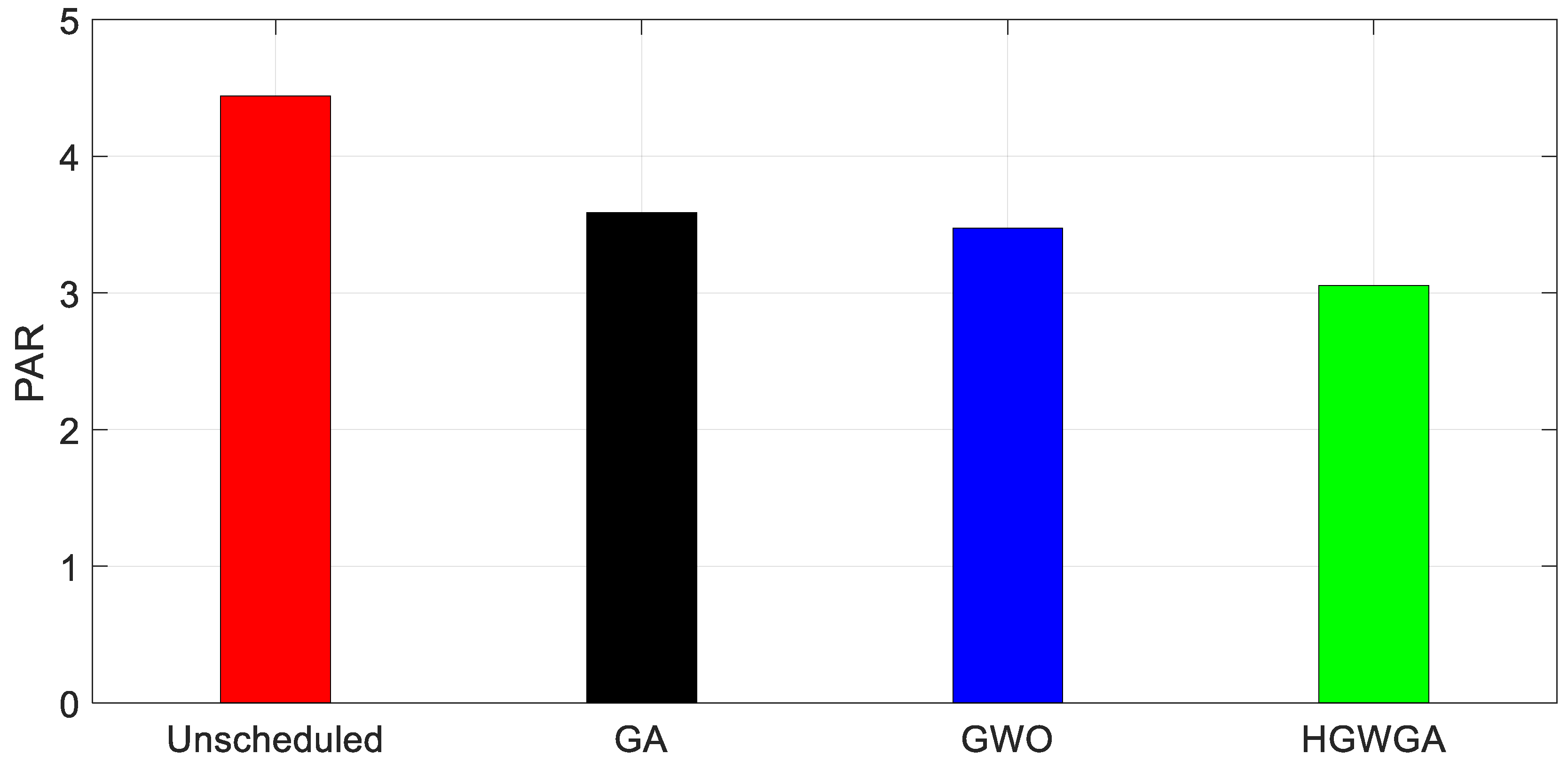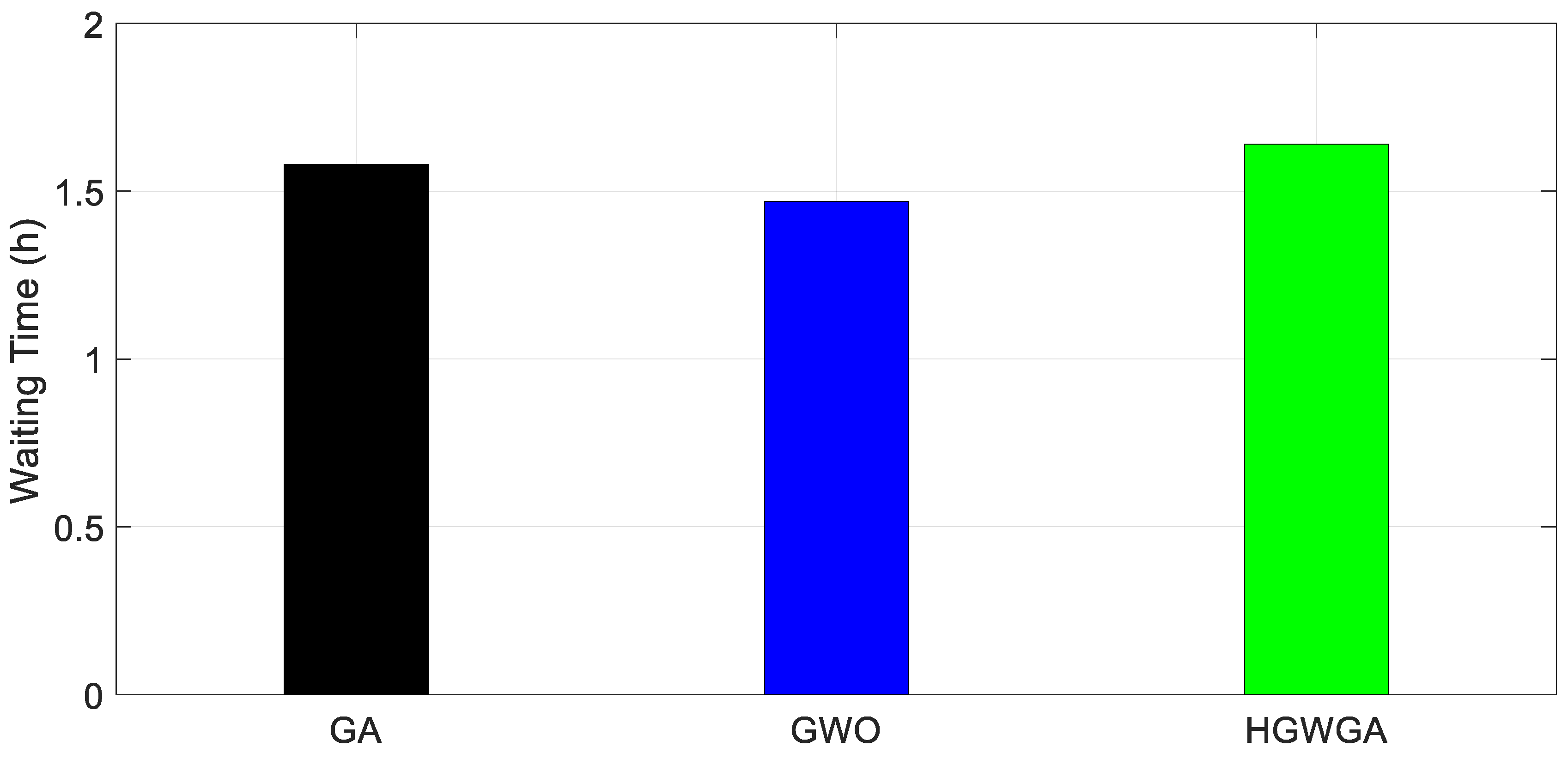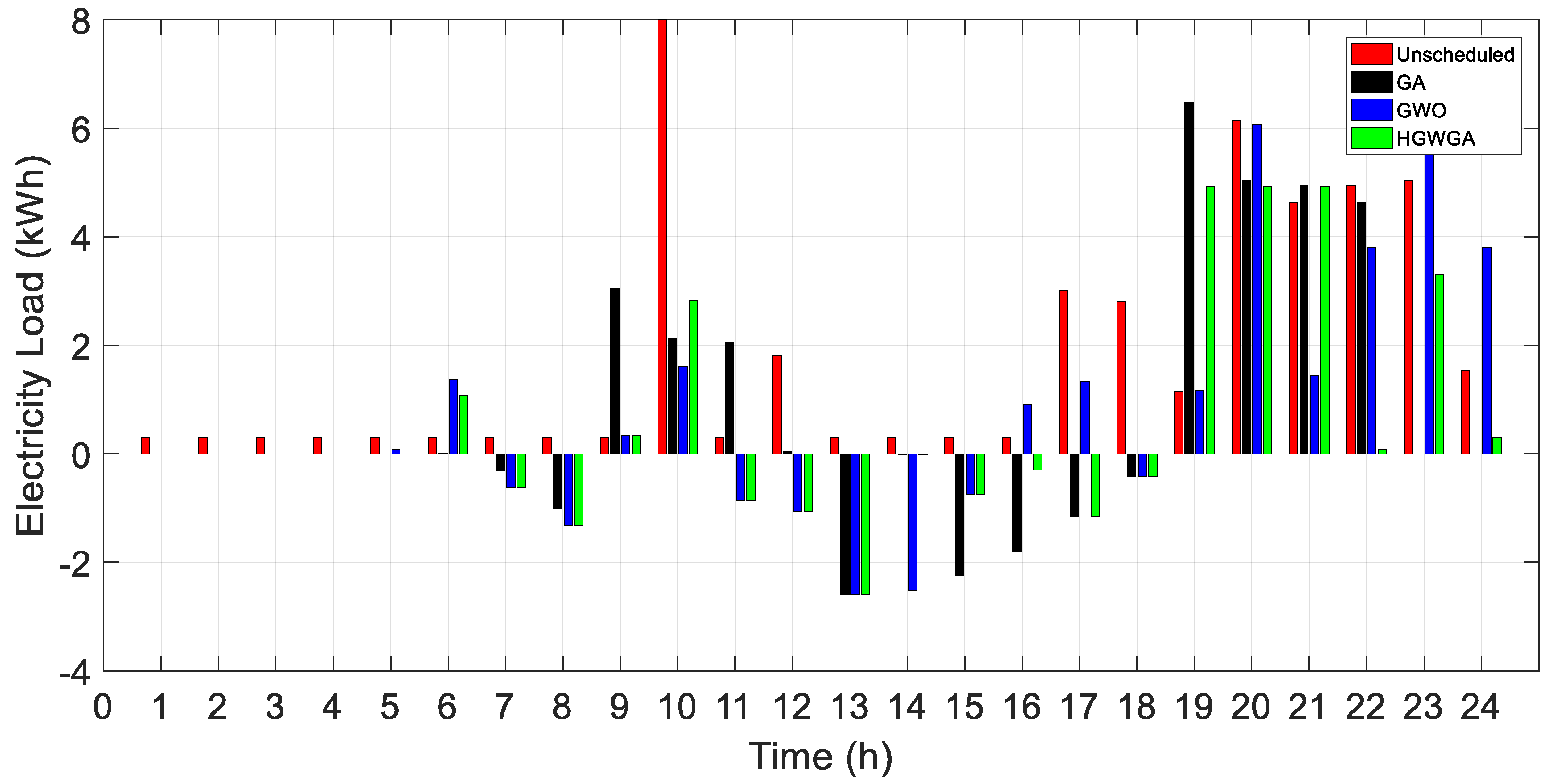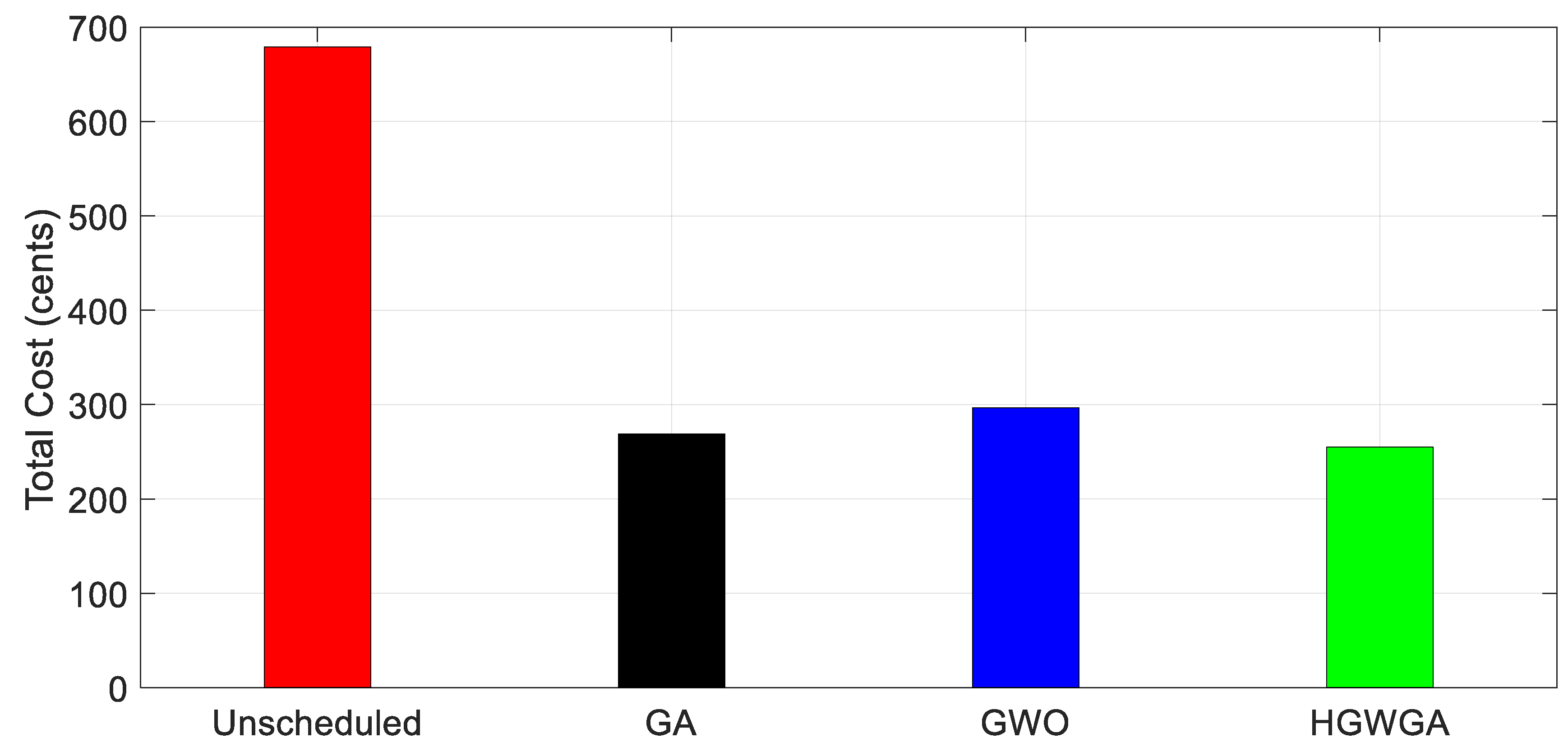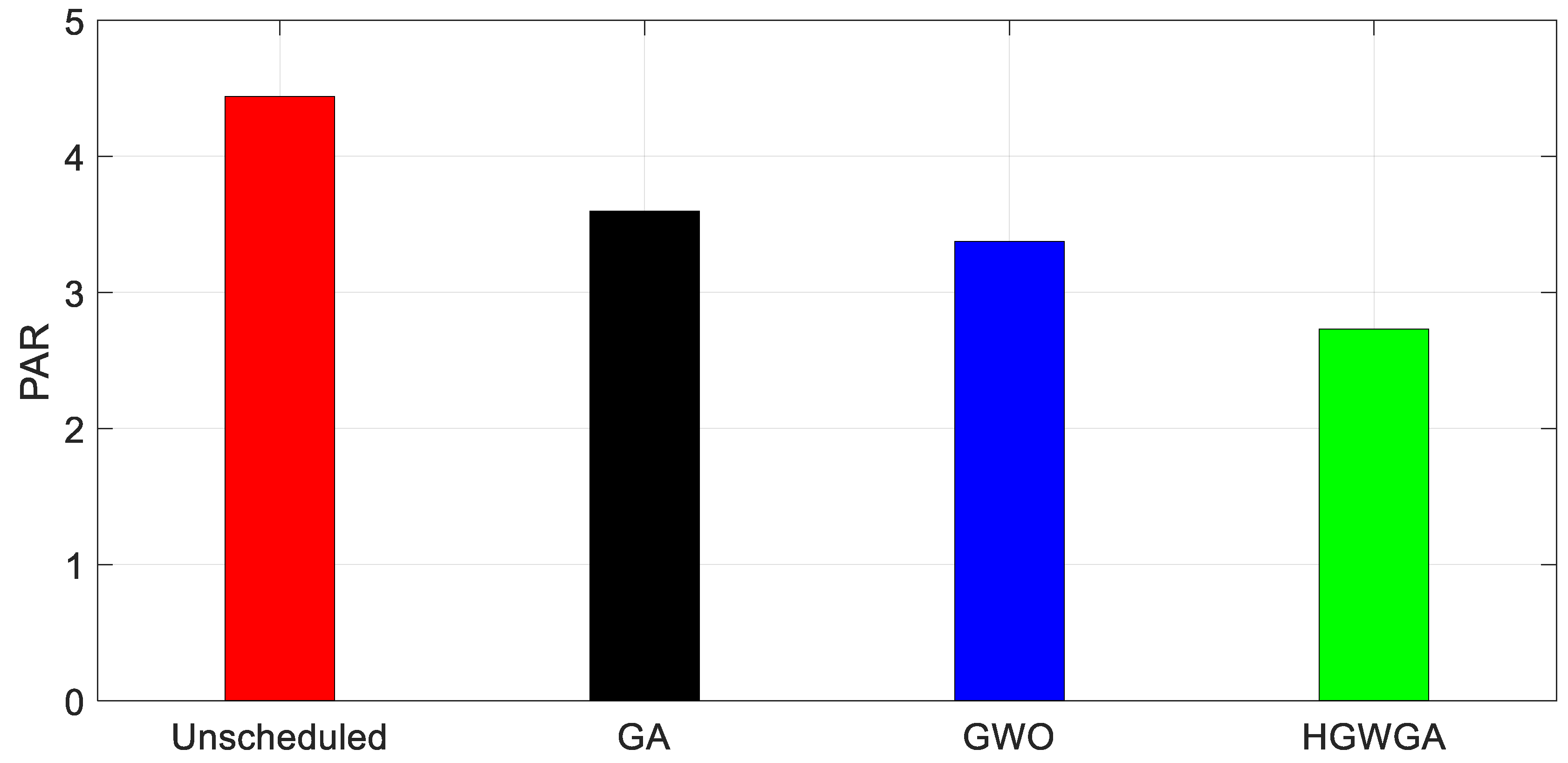1. Introduction
The increasing costs of energy and environmental contamination are major concerns in today’s world [
1]. As most of the power plants rely on fossil fuel resources for electricity production, they are depleting at a fast rate. Moreover, the increased utilization of fossil fuels is resulting in global warming, which is a challenging issue to deal with. These seminal drivers have led to the belief that the need for public and private decision-makers to transition toward green and sustainable energy is inexorable. The integration of renewable energy resources (RERs), especially solar and wind, is a handy option for generating green electricity with reduced global warming effects [
2,
3].
These factors lead us to the concept of a smart grid, which is a digital, bidirectional network of distributed generators. Due to installed sensors, it has the capabilities of self-monitoring, self-healing, remote control, and pervasive control [
4,
5]. A smart grid offers opportunities for maximum energy savings by organizing energy management systems (EMSs) and their functions. It relies on intelligent control devices to establish an efficient communication between the consumer and utility provider.
Mutual coordination between electric grids, utility operators, and smart homes is the main point that allows a smart grid to work accurately. A major part of electrical energy is being utilized for serving residential communities. According to Lior [
6], 30–40% of the overall supplied energy is used in residential houses. Therefore, energy management in residential homes plays an important role in reducing the consumption of electrical energy supplied by the grid to diminish the peak load on grids. With the improvement in control and communication methodologies, home energy management systems (HEMSs) are playing an important role in reducing electricity consumption in residential buildings. An optimal collaboration between smart homes and the utility provider due to HEMS decreases electricity consumption cost [
7].
Moreover, an optimum collaboration between smart homes and a smart grid saves 10–30% of electrical energy consumed from the grid [
8]. Electricity providing utilities introduced different dynamic tariff structures to encourage the electricity customers to decrease their consumption in high-tariff time slots [
9,
10]. Based on this information, a smart grid utilizes supply-side management (SSM) and demand-side management (DSM) tools for energy conservation. The optimization activities covered in SSM are implemented regarding the generation, transmission, and distribution sides of the energy chain, while in DSM, the consumer side load management is performed based on the demand response. The electricity consumption charges may be reduced by shifting household appliances from a peak tariff time to an off-peak tariff time.
The users can get maximum benefits in terms of a decrease in electricity consumption charges, reduction in the peak-to-average ratio (PAR) and avoiding energy blackouts due to two features of DSM, namely the demand response (DR) and load management (LM) [
11]. DR programs play a significant role in a smart grid operation by scheduling household appliances from away from high-tariff time slots to low-tariff time slots according to time-based electricity tariffs, which are explained in References [
9,
12].
DR programs are further classified into two types, i.e., incentive-based (IB) and price-based (PB) DR programs.
Figure 1 represents the classification of DR programs.
In IB DR programs, the utility wirelessly shifts home appliances to an OFF state by sending a short notice to consumers whenever a peak demand occurs in any time slot [
13]. Using the PB DR programs, the electricity utilities encourage the electricity users to adopt efficient scheduling strategies such that they can minimize their electrical energy consumption and reduce their electricity consumption costs [
14].
This paper focuses on PB DR programs with the integration of RERs, and energy storage system (ESS), and a smart meter at each home. The smart meter continuously provides information related to hourly tariffs that are declared by the electricity provider to the consumer. Due to this, the electricity users schedule their hourly load according to the declared utility tariffs. This hourly electricity load management is useful for both electricity consumers and electricity providers in terms of reducing electricity consumption costs and improving the stability of the power system.
In the proposed HEMS scheme, an ESS and photovoltaic (PV) generation system were further integrated to improve the performance of the primitive HEMS. Three optimization algorithms, i.e., a genetic algorithm (GA); grey wolf optimization (GWO); and the proposed hybrid technique based on GWO and GA, named a hybrid grey wolf genetic algorithm (HGWGA), that considers real-time pricing (RTP) and critical peak pricing (CPP) tariff schemes, were used to solve the scheduling problem. Simulation results demonstrate that the proposed hybrid optimization technique performed well at reducing the PAR and consumption costs of electricity. However, there is always a trade-off between consumer electricity consumption cost and consumer appliance waiting time (AWT). Whenever the consumer electricity consumption cost was at a minimum, the consumer AWT was at a maximum and vice versa.
Contributions
The main contributions of this paper are:
The application of a hybrid optimization technique (HGWGA) to effectively solve the appliance scheduling problem.
The integration of stochastic models of ESS, a PV system, and loads for optimal scheduling.
The investigation of RTP and CPP tariffs using the proposed model for optimal scheduling.
The rest of the paper is organized in the following manner.
Section 2 presents a technological review of the literature, while in
Section 3, mathematical models of a HEMS are discussed.
Section 4 formulates the load scheduling problem by discussing issues regarding consumer energy consumption, electricity consumption cost, PAR, AWT, and the objective function. The heuristic optimization techniques implemented to solve the scheduling problem are explored in
Section 5.
Section 6 and
Section 7 contain the case studies and simulations results, respectively, while
Section 8 summarizes the paper with concluding remarks.
2. Literature Review
The optimal scheduling of smart home appliances is a challenging problem that is focused on by many researchers. The main objective is to minimize the consumption cost of electricity and achieve a load balance among the supply and demand sides. In the last few decades, several methodologies and techniques have been proposed by researchers for minimizing users’ electricity consumption cost, reducing the PAR, and maximizing the consumers’ comfort.
The optimum scheduling and operation of home appliances is a non-linear, discrete, and multi-dimensional problem with multiple constraints. Several traditional, evolutionary, and swarm intelligence techniques, such as mixed-integer programming (MILP), real-time rolling optimization (RTRO), bat algorithm (BA), GWO, and particle swarm optimization (PSO), etc., are considered in the literature to solve the home appliance scheduling problem [
15,
16].
Zhang et al. [
17] proposed a scheduling strategy using MILP to optimally operate household appliances for achieving a reduction in the emission rate, energy import from the grid, and financial burden on the user. Bradac et al. [
18] presented a scheduling technique to minimize the electricity consumption cost with a PAR reduction for residential consumers in peak hours using MILP. However, their proposed model did not consider consumers’ comfort.
Huang et al. extended the work presented in Bradac et al. [
18] using heuristic techniques for reducing residential energy consumption during peak hours and cost minimization while incorporating consumers’ comfort as well [
19]. Lokeshgupta and Sivasubramani [
20] proposed an optimal strategy for a HEMS with the objectives of cost minimization and peak load reduction while incorporating an energy storage system (ESS). A MILP technique was used to solve this multi-objective problem for residential customers using a time-of-use (ToU) pricing scheme that offers low prices during the off-peak and the mid-peak hours while offering high prices during the peak hours. The integration of RERs was not considered in their proposed scheme.
Kuzlu [
21] presented a score-based intelligent home energy management algorithm for attaining the optimum scheduling of home appliances by considering an electricity purchase tariff and the PAR. RERs and ESS were not considered in their proposed model.
A GA-based model of a HEMS was proposed in Mohamed and Koivo [
22] with the purpose of reducing the consumption cost of electricity for residential consumers. Models based on evolutionary algorithms were proposed in References [
23,
24] to solve an energy-based optimization problem in a residential area. In the proposed models, authors presented a strategy for the scheduling of household appliances in different time intervals to minimize electricity consumption expenses and the PAR. However, the integration of RERs and an ESS were not considered in these models.
A PSO is a swarm intelligence algorithm that is frequently implemented for the optimal scheduling of the HEMS [
25]. Rehman et al. developed a binary PSO (BPSO) algorithm in Rehman et al. [
26]. Their proposed algorithm automatically controlled the appliance scheduling by shifting the consumers’ load from a high-pricing time to a low-pricing time. Since a PSO is appropriate for solving real number optimization problems, it might get stuck in a local optimum value in discrete optimization problems. HEMS is a discrete problem; therefore, a PSO algorithm is not suitable for this type of problem [
27].
Liao et al. [
28] proposed an electron drifting algorithm (EDA) to optimally operate household appliances for achieving a reduction in the emission rate, energy import from the grid, and financial burden on the user. The main strength of the proposed EDA compared to other algorithms was its lower probability of getting stuck in a local minimum. However, this algorithm lacks the availability of explicit rules for constraints handling, which results in a high uncertainty.
Javaid et al. [
29] applied a GA, BPSO, and a Cuckoo search optimization algorithm (CSOA) to develop an optimal scheduling strategy for residential appliances in the presence of an ESS and RERs. The objective of the implemented idea was to reduce the consumers’ electricity cost under a ToU tariff scheme and minimize the PAR.
Basit et al. [
30] presented a model to solve an appliance scheduling problem by using the Dijkstra algorithm and reducing the system complexity. Integration of the ESS and RERs were not considered in their proposed model.
The minimization of the consumption cost of electricity in a smart grid environment using an evolutionary technique was discussed in Mary and Rajarajeswari [
31] through the integration of an ESS. During a low electricity tariff time, energy was stored in the ESS and it was utilized during the peak-tariff time. Charging and discharging limits of the battery per time slot were also defined by the authors to avoid battery damage. However, the authors did not consider the installation cost of the storage system.
An innovative technique was proposed in Bharathi and Vijayakumar [
32] to keep the supply demand balance in residential, commercial, and industrial areas. The authors compared the electrical consumption of different residential consumer’s datasets via a GA-assisted DSM and a simple DSM. Simulation results demonstrated that a DSM with a GA (DSM-GA) gave better results than a DSM without GA. The PAR and consumer comfort were not considered by the authors in their proposed model.
Asgher et al. presented a strategy for residential load management with the integration of RERs [
33]. Their proposed scheme used a GA to optimally schedule the load demand using a day-ahead pricing (DAP) tariff to meet the cost-minimization and PAR-reduction objectives.
Sharifi and Maghouli [
34] proposed a novel scheduling mechanism for home appliances to reduce the consumption costs and the PAR. The scheduling model is implemented in inclined block rate (IBR) and real-time pricing schemes to avoid a peak demand during low-tariff times, which would improve the PAR index as well. A non-dominated sorting genetic algorithm (NSGA) was adopted to solve the optimization problem in a MATLAB simulation environment.
Aslam et al. [
35] proposed a scheduling technique for minimizing the residential consumer electrical energy consumption and reducing the PAR with the help of the heuristic techniques of a GA, CSOA, and a Crow search algorithm (CSA) under RTP and CPP tariff schemes. However, the integration of RERs was not considered in their proposed model.
Hafeez et al. [
36] formulated a scheduling problem for residential consumer home appliances using a GA, BPSO, wind-driven optimization (WDO), and hybrid framework of a GA and WDO. The minimization of the electricity consumption cost and the decrease in the PAR were the main objectives in the RTP and inclined block rate (IBR) tariff schemes. The simulation results demonstrated that the above-mentioned methodology achieved the defined objectives in an effective way. However, in the proposed scheme, the authors did not consider the H2G energy exchange environment.
Tsui and Chan [
37] developed a scheduling scheme for residential consumer home appliances using convex programming (CP) to minimize the electricity consumption cost and decrease in the PAR. In this model, the RTP tariff scheme was used for the calculation of the electricity consumption cost. It can be concluded from the results that the proposed model is able to effectively achieve the objectives.
To maintain the balance between the residential electrical energy demand and supply, a fuzzy logic (FL)-based model is presented in Wu et al. [
38]. An ESS and PV system are also integrated in their scheduling scheme. The proposed scheme has the ability to schedule the home appliances, ESS, and PV in an optimal way.
Naz et al. [
39] applied an enhanced differential evolution algorithm (EDEA), GWO, and a hybrid framework of EDEA and GWO to develop an optimal scheduling strategy for residential appliances in the presence of an ESS and RERs. The implemented idea was to minimize the consumer electricity cost and reduction in the PAR under RTP and CPP tariff schemes.
Khan et al. [
40] designed a scheduling problem for residential consumer home appliances by using a harmony search algorithm (HSA), EDEA, and a hybrid framework of HSA and EDEA. The minimization of the electricity consumption charges and decrease in the PAR were the main objectives. In this model, the RTP tariff scheme was used for the electricity consumption cost calculation. Simulation results demonstrated that the above-mentioned methodology achieved the defined objectives in an effective way.
Setlhaolo et al. [
41] developed a model for residential consumers to diminish their electricity consumption charges under a ToU tariff scheme. They applied a mixed-integer non-linear programming (MINLP) scheme without considering the PAR in their proposed model.
An integer linear programming (ILP) scheme was proposed for residential areas in Zhu et al. [
42] to meet the supply–demand balance objective while reducing the consumption cost of electricity. Since the proposed scheme could schedule the home appliances in an optimal way, the supply–demand balance goal was achieved after the optimal scheduling of household appliances for several consumers. This study ignores the users’ comfort in the modeling.
A dynamic programming (DP)-based appliance scheduling model is proposed in Samadi et al. [
43] for the optimal shifting of consumers’ household appliances in a defined time interval by considering the appliance preferences set by the consumers. The main aim of this scheduling strategy was to decrease the consumer electricity consumption charges by rescheduling consumer home appliances from a high-tariff time interval to a low-tariff time interval according to their preferences.
Keeping in mind the above literature, it can be summarized that the design of a HEMS has been optimized by various algorithms: MILP, EDA, linear programming (LP), PSO, DP, convex programming (CP), bacterial foraging algorithm (BFA), score-based intelligent home energy management algorithm, ILP, Dijkstra algorithm, and MINLP. Nevertheless, in some scenarios, these techniques are unable to deal with the volatile nature of different appliances. Furthermore, the convergence rate in some cases was found to be extremely slow because these algorithms were often stuck in local minimum solution. Some important practical constraints, such as the maximization of user comfort, dynamic pricing scheme, and the integration of an ESS and RERs, are somehow rarely considered while using such techniques. In addition, previously proposed models were based on the deterministic modeling of the load, ESS, and RERs. As RERs, such as solar and wind, are weather-dependent, the energy produced by these resources is variable and uncertain. This variability is generally modeled through stochastic or probabilistic approaches. Therefore, this paper presents an optimal design of a HEMS incorporated with the probabilistic modeling of the loads, ESS, and PV by considering RTP and CPP tariff schemes to provide a reduced consumption cost and a better consumption pattern, which indicates reduction in PAR using a GWO, GA, and the proposed hybrid (HGWGA) technique.
6. Case Study
In this paper, a residential consumer load was comprised of multiple appliances with an ESS, and PV generation was considered for the implementation of the proposed methodology. We considered 12 household appliances in this study. Seven base loads were considered, which could complete their operating time in single or multiple cycles. These cycles may be consecutive or split within the consumer’s preferred time span. For example, an electrical car can be charged in any consecutive 3 h from 18:00 to 06:00. In addition, it can also be charged in two separate cycles summing to 3 h of charging, e.g., 20:00 to 22:00 and 05:00 to 06:00. Another option may be to charge the car in three disconnected hours, e.g., 19:00 to 20:00, 23:00 to 24:00, and 04:00 to 05:00 can be possible hours that are not continuous but sum to an operating duration of 3 h. Such different possible combinations are tested by the proposed algorithm and the optimal operating schedule of the appliance was generated. An additional operating constraint for non-deferrable appliances, such as interior lighting, was that their operation could not be shifted, while deferrable loads could be shifted in terms of their allocated time. Three deferrable and two non-deferrable appliances were considered in this study. Different consumer load parameters with respect to their operating preferences are given in
Table 4.
The solar irradiance data used in the study was collected from Khan [
48] and characteristics of this data was modeled by using the beta-probability-distribution-based model to generate daily solar irradiance patterns. The daily solar irradiance patterns of original dataset and scenarios generated after the beta distribution modeling are presented in
Figure 5. In this study, the generated solar irradiance data was used for calculating the PV generation by randomly selecting a pattern for each run of the simulation. The output power of the PV generation was calculated using Equations (10)–(12). Limits and other capacity restrictions of the different system components, such as the PV, grid, and battery, are given in
Table 5. Two different pricing schemes—RTP and CPP—were considered in this study. Both schemes had the same prices of energy except from 08:00 to 11:00, where the CPP scheme charged more than RTP. The peak price in both schemes was observed between 10:00 to 11:00, as shown in
Figure 6. Furthermore, it was assumed that the tariff for the H2G energy export was half of the pricing charged in the energy import from the G2H [
27]. Three different scenarios considering PV generation, the ESS (battery), and grid supply were analyzed in this study. The details considered regarding these scenarios are given in
Table 6. These scenarios depict the impact of the optimal appliance scheduling on the operating cost of the electricity by considering the absence and presence of PV or/and an ESS.
8. Conclusions
In this paper, a HEMS model was proposed for residential electricity consumers using multiple appliances with an ESS and PV generation including the option of a H2G energy exchange. A new optimization technique called HGWGA was proposed and implemented to solve the residential consumer appliance scheduling problem in the presence of an ESS and PV. The proposed hybrid algorithm was developed by combining the attributes of GWO and the GA to reduce the consumer electricity consumption cost and the PAR while considering RTP and CPP tariff schemes. To substantiate the performance, the strength and effectiveness of the proposed technique, three scenarios were considered, and the obtained results were compared with GWO, the GA, and unscheduled cases. From
Table 7, it is clear that for all three scenarios, the total electricity consumption cost was reduced by 14.93%, 24.39%, and 43.22%, respectively, through the optimal appliance scheduling using the proposed HGWGA in case of just the RTP signal being present. Similarly, when the CPP signal was incorporated, the electricity consumption cost decreased by 25.15%, 39.73%, and 62.45%, and the PAR was reduced by 30%, 31.25%, and 38.5%, respectively. For all three scenarios, the percentage reduction in cost and the PAR for both the RTP and CPP tariffs displayed the effectiveness of the proposed hybrid technique. The results of the execution time demonstrated that the convergence rate of the proposed HGWGA for the scheduling of appliances was comparatively fast, and therefore, this technique can be a better choice in real-time applications in SMSUs for load scheduling.
The proposed algorithm for the optimal appliance scheduling strategy can be applied to actual data when and where they are provided. It not only reduced the energy cost, but also increased the stability and reliability of the grid. In addition, the contribution of scheduling results for several HEMSs can be important for an aggregator to manage its resources for a cost-effective and reliable operation of a microgrid.
This work focused on residential loads; however, an increase in the number of appliances and the incorporation of loads of other energy sectors, i.e., industrial and commercial, is planned for future work. In future, RERs including PV, wind, biogas, etc., will be integrated with the conventional energy generation resources to develop a hybrid energy generation system. Battery electric vehicles (BEV) and plug-in hybrid electric vehicles (PHEV) will be considered for the ESS. To improve the performance of the proposed methodology and to diminish the effects of uncertainties, stochastic models of DR strategies can be used. A hybrid of the proposed heuristic technique and fuzzy techniques can be used to further enhance the performance in the future.

